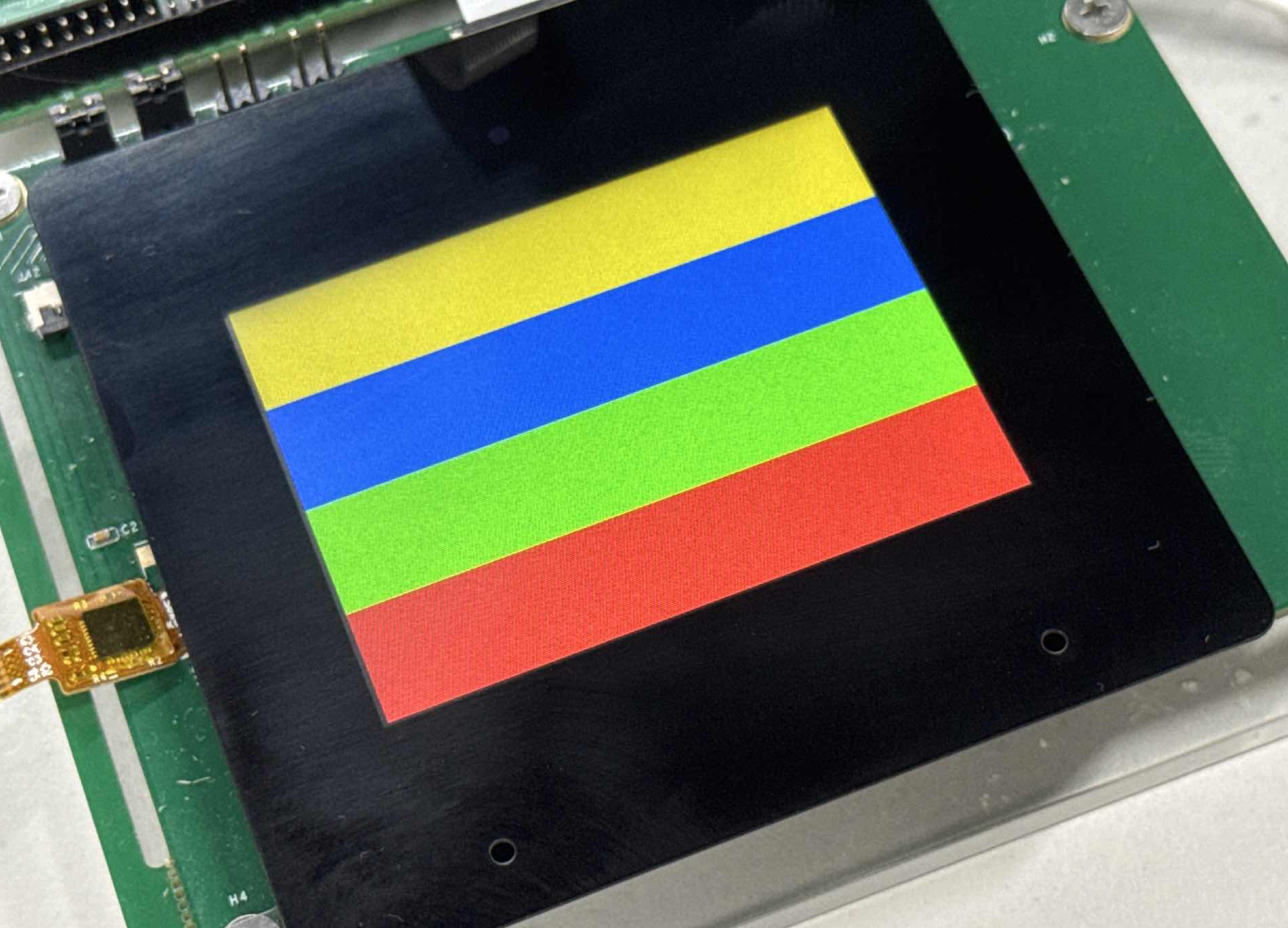SPI LCD 使用 DE 加速合成
在 1.0.7 版本驱动中,新增了 SPI LCD 通过 DE RTWB 回写实现 DE 加速合成的功能。
由于 SPI 屏是纯 CPU 软件屏,没有类似于 I8080,RGB 屏幕的 DE+TCON 硬件合成执行的功能,所以当执行一些 YUV 转 RGB 显示,多通道合成的时候会比较吃力,需要用 CPU 纯软件的合成转换,此时可以使用 DE 硬件的回写功能,使用 DE 的硬件合成加速,将输出的数据显示在 SPI 屏上。其流程如下:
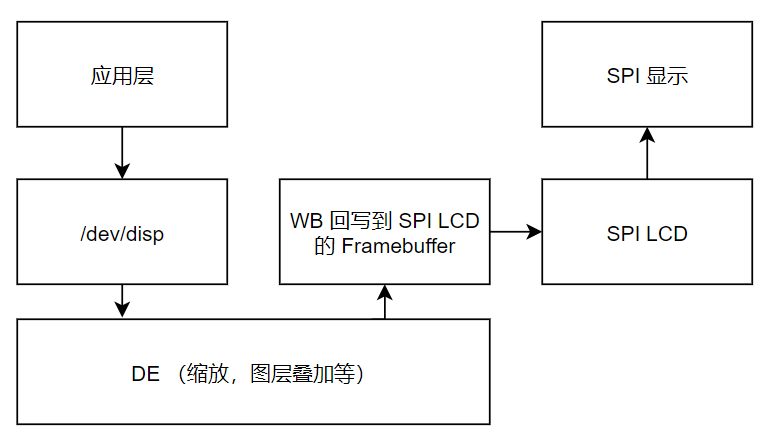
整个框架包括四个流程:
- 应用层通过操作
/dev/disp节点,设置送显,送图层,绑定显示通道 - 应用层获取 SPI LCD 的显存 FD,将其传入 DISP 驱动
- 触发 DE 硬件执行合成和回写,将图像数据写道 SPI LCD 的显存中
- 执行 PANDISPLAY 操作,通知 SPI LCD 进行刷屏操作
这套加速方案有一定的限制性,需要符合这些要求才可以使用
- DE 模块需要完全交给显示使用,不可以作为双屏显示,或者独立执行其他缩放操作
- DE 模块仅能回写 RGB888,ARGB888 的数据,所以要求 SPI 屏幕需要支持 RGB888 或者支持 RGB666,若是 RGB666,其时序需要支持丢弃 BIT,使得送显数据 RGB888 但是实际屏幕显示 RGB666
- SPI 屏幕显示需要支持 TE
- 方案会占用较多内存,需要较多 buffer
- 目前仅支持 Video 通道送 YUV 显示,RGB + YUV 合成还不支持
这里以 DBI RGB666 时序为例,可以看到 RGB666 的送图格式中,每个颜色都需要发送两个 dummy clock,这两个数据会被屏幕自动丢弃,所以我们可以直接送显 RGB888 的数据,屏幕配置为 RGB666,屏幕自行丢弃低位两个不需要的 data,达到屏幕配置 RGB666,送显 RGB888 的功能。
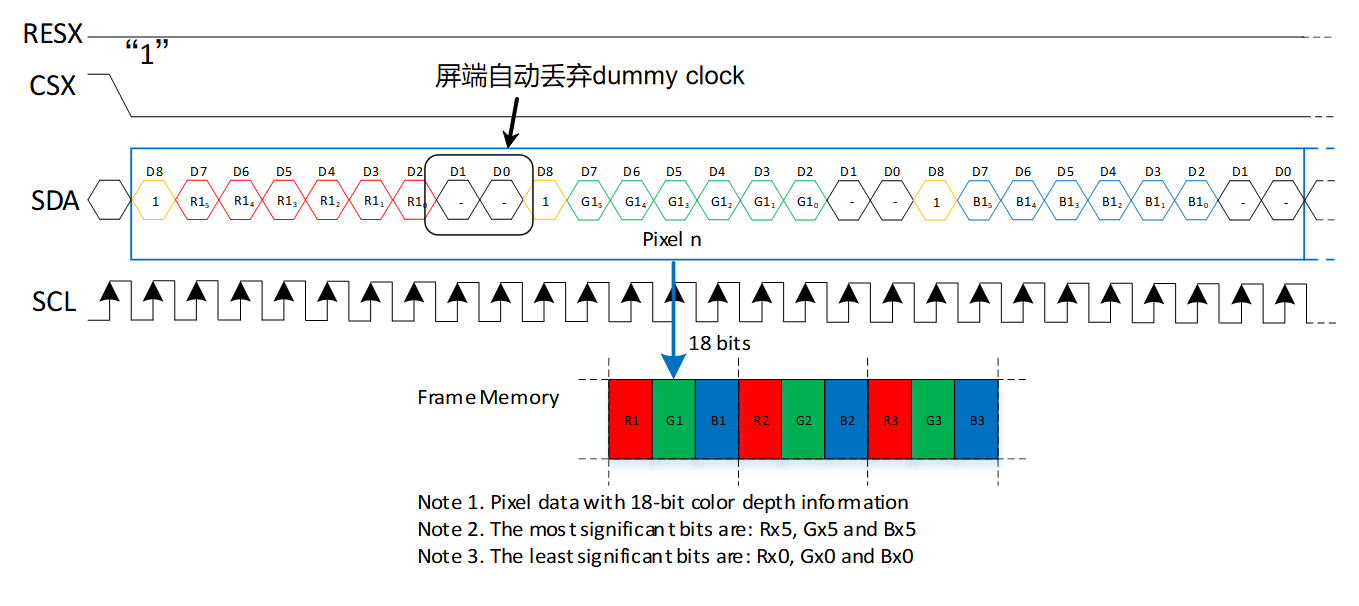
参考 QSPI,也有类似的丢弃

另外由于DE回写与屏幕送显是完全异步的操作,所以需要多块 buffer 轮转送显,一般 VI 送帧 20fps,需要配置 3 块 buffer。
配置功能
内核模块配置
需要配置这些模块
CONFIG_AW_DISP2=y
# CONFIG_AW_DISP2_PQ is not set
# CONFIG_AW_HDMI_TX_DISP2 is not set
CONFIG_LCD_FB=y
CONFIG_AW_LCD_FB_USE_ION=y
首先配置 LCD FB 显示驱动模块,配置路径如下所示:
Allwinner BSP --->
Device Drivers --->
Video Drivers --->
SPI LCD Panel Drivers --->
<*> LCD FB Driver Support (SPI LCD)
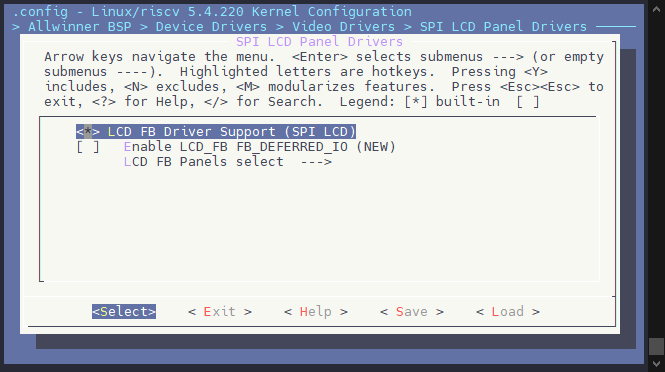
LCD 显示面板驱动位于
Allwinner BSP --->
Device Drivers --->
Video Drivers --->
SPI LCD Panel Drivers --->
LCD FB Panels select --->
[*] LCD support kld2844B panel
...
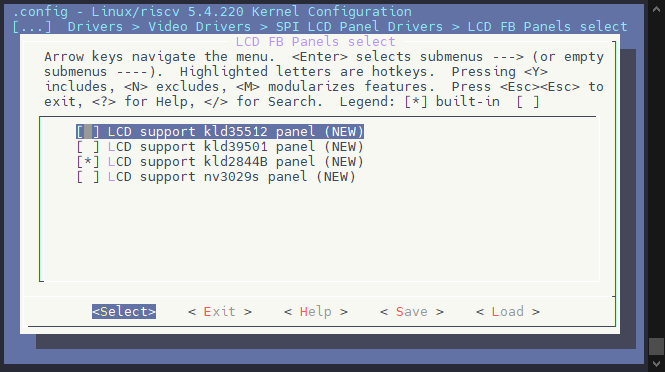
然后需要配置 LCD_FB 使用 ION 内存申请
Allwinner BSP --->
Device Drivers --->
Video Drivers --->
SPI LCD Panel Drivers --->
[*] LCD_FB use ION for framebuffer (Linux <= 5.4)
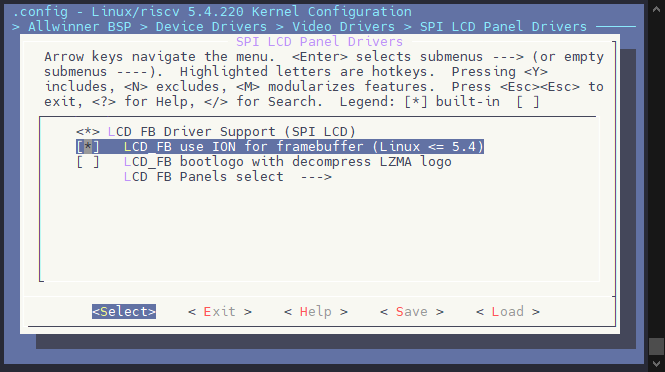
然后需要配置 DISP2 驱动,启用 DE 功能
Allwinner BSP --->
Device Drivers --->
Video Drivers --->
<*> DISP Driver Support(sunxi-disp2)
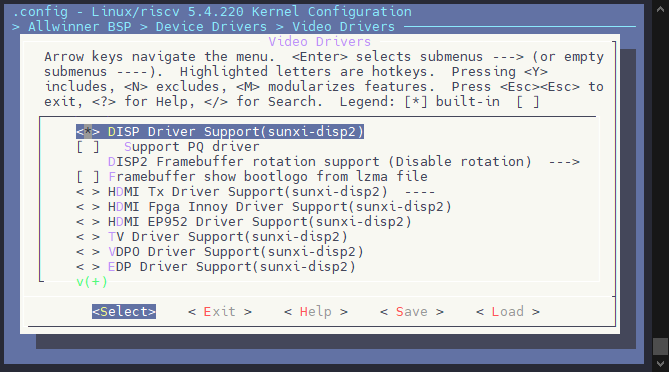
设备树配置
LCD FB 相关配置,配置 SPI 屏的一些细节
&pio {
dbi1_pins_default: dbi1@0 {
pins = "PD1", "PD2", "PD3"; /* dbi-cs, dbi-clk, dbi-sdo */
function = "spi1";
allwinner,drive = <3>;
};
dbi1_pins_dcx: dbi1@1 {
pins = "PD5"; /* dbi-dcx */
function = "spi1_hold";
allwinner,drive = <3>;
bias-pull-up;
};
dbi1_pins_te: dbi1@2 {
pins = "PD6"; /* dbi-te */
function = "spi1_wp";
allwinner,drive = <3>;
bias-pull-up;
};
dbi1_pins_sleep: dbi1@3 {
pins = "PD1", "PD2", "PD3", "PD5", "PD6";
function = "io_disabled";
};
};
&spi1 {
pinctrl-0 = <&dbi1_pins_default &dbi1_pins_dcx &dbi1_pins_te>;
pinctrl-1 = <&dbi1_pins_sleep>;
pinctrl-names = "default", "sleep";
/*Set SUNXI_SPI_BUS_DBI when using SPI LCD*/
sunxi,spi-bus-mode = <SUNXI_SPI_BUS_DBI>;
/*sunxi,spi-bus-mode = <SUNXI_SPI_BUS_MASTER>;*/
sunxi,spi-cs-mode = <SUNXI_SPI_CS_AUTO>;
status = "okay";
spi_panel_spi1: slave@0 {
device_type = "spi-panel";
compatible = "allwinner,spi-panel";
reg = <0x0>;
spi-max-frequency = <100000000>;
lcd_used = <1>;
lcd_driver_name = "kld2844b";
lcd_if = <1>;
lcd_dbi_if = <4>;
lcd_data_speed = <48>;
lcd_spi_bus_num = <1>;
lcd_x = <240>;
lcd_y = <320>;
lcd_pixel_fmt = <0>; /* 配置 fb 为 ARGB888 */
lcd_dbi_fmt = <3>; /* 屏幕为 RGB666 */
lcd_rgb_order = <0>;
lcd_width = <60>;
lcd_height = <95>;
lcd_pwm_used = <1>;
lcd_pwm_ch = <6>;
lcd_pwm_freq = <5000>;
lcd_pwm_pol = <1>;
lcd_frm = <1>;
lcd_gamma_en = <1>;
fb_buffer_num = <2>;
lcd_backlight = <100>;
lcd_fps = <60>;
lcd_dbi_te = <0>;
lcd_dbi_clk_mode = <0>;
lcd_gpio_0 = <&pio PD 4 GPIO_ACTIVE_LOW>; /* reset */
/*lcd_spi_dc_pin = <&pio PD 5 GPIO_ACTIVE_HIGH>;*/
status = "okay";
};
};
&lcd_fb {
status = "okay";
port {
#address-cells = <1>;
#size-cells = <0>;
spi_panel0: endpoint@0 {
reg = <0>;
remote-endpoint = <&spi_panel_spi1>;
};
};
};
DISP DE 硬件设备树配置
&disp {
disp_init_enable = <1>;
disp_mode = <0>;
screen0_output_type = <7>; /* 配置为 RTWB 回写模式 */
screen0_output_mode = <4>;
screen0_to_lcd_index = <0>;
screen1_output_type = <3>;
screen1_output_mode = <10>;
screen1_to_lcd_index = <2>;
screen1_output_format = <0>;
screen1_output_bits = <0>;
screen1_output_eotf = <4>;
screen1_output_cs = <257>;
screen1_output_dvi_hdmi = <2>;
screen1_output_range = <2>;
screen1_output_scan = <0>;
screen1_output_aspect_ratio = <8>;
fb_format = <0>;
fb_num = <1>;
fb_debug = <0>;
/*<disp channel layer zorder>*/
fb0_map = <0 0 0 16>;
fb0_width = <240>; /* fb分辨率,需要与 SPI 屏幕一致 */
fb0_height = <320>; /* fb分辨率,需要与 SPI 屏幕一致 */
/*<disp channel layer zorder>*/
fb1_map = <0 2 0 16>;
fb1_width = <240>; /* fb分辨率,需要与 SPI 屏幕一致 */
fb1_height = <320>; /* fb分辨率,需要与 SPI 屏幕一致 */
/*<disp channel layer zorder>*/
fb2_map = <1 0 0 16>;
fb2_width = <240>; /* fb分辨率,需要与 SPI 屏幕一致 */
fb2_height = <320>; /* fb分辨率,需要与 SPI 屏幕一致 */
/*<disp channel layer zorder>*/
fb3_map = <1 1 0 16>;
fb3_width = <240>; /* fb分辨率,需要与 SPI 屏幕一致 */
fb3_height = <320>; /* fb分辨率,需要与 SPI 屏幕一致 */
chn_cfg_mode = <1>;
disp_para_zone = <1>;
};
&lcd0 {
lcd_used = <1>;
lcd_driver_name = "default_lcd";
lcd_if = <0>;
lcd_hv_if = <8>;
lcd_x = <240>; /* fb分辨率,需要与 SPI 屏幕一致 */
lcd_y = <320>; /* fb分辨率,需要与 SPI 屏幕一致 */
lcd_width = <108>;
lcd_height = <64>;
lcd_dclk_freq = <27>; /* 任意即可 */
lcd_hbp = <70>;
lcd_ht = <1716>;
lcd_hspw = <1>;
lcd_vbp = <21>;
lcd_vt = <263>;
lcd_vspw = <1>;
};
应用编写流程
应用流程如下所示:
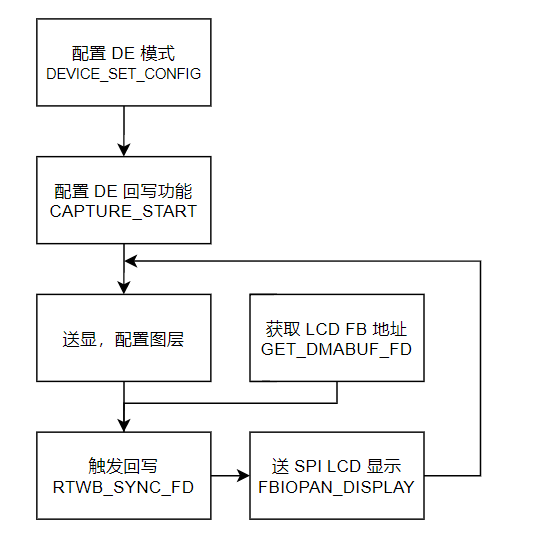
- 先配置 DISP 模式,配置分辨率到回写模式
struct disp_device_config conf;
memset(&conf, 0, sizeof(conf));
conf.type = DISP_OUTPUT_TYPE_RTWB;
conf.mode = DISP_TV_MOD_480P;
conf.timing.x_res = WIDTH;
conf.timing.y_res = HEIGHT;
conf.timing.frame_period = 16666667; //60hz
conf.format = DISP_CSC_TYPE_RGB;
conf.cs = DISP_BT709;
conf.bits = DISP_DATA_8BITS;
conf.eotf = DISP_EOTF_GAMMA22;
conf.range = DISP_COLOR_RANGE_16_235;
conf.dvi_hdmi = DISP_HDMI;
conf.scan = DISP_SCANINFO_NO_DATA;
unsigned long arg[4] = { 0 };
arg[0] = 0;
arg[1] = (unsigned long)&conf;
ioctl(disp_fd, DISP_DEVICE_SET_CONFIG, (void *)arg);
- 配置 DE 开启回写功能
struct disp_capture_init_info capture_info;
capture_info.port = DISP_CAPTURE_AFTER_DEP;
unsigned long arg[4] = { 0 };
arg[0] = 0;
arg[1] = (unsigned long)&capture_info;
ioctl(disp_fd, DISP_CAPTURE_START, (void *)arg);
- 获取 LCD FB 的 DMABUF FD 操作符
struct lcd_fb_dmabuf_export dmabuf_info;
ret = ioctl(fb_fd, LCDFB_IO_GET_DMABUF_FD, &dmabuf_info);
if (ret == -1) {
perror("ioctl failed");
goto err;
}
- 配置 DE 启用回写功能
struct disp_capture_init_info capture_info;
capture_info.port = DISP_CAPTURE_AFTER_DEP;
unsigned long arg[4] = { 0 };
arg[0] = 0;
arg[1] = (unsigned long)&capture_info;
ioctl(disp_fd, DISP_CAPTURE_START, (void *)arg);
- 触发一次回写操作
配置回写操作主要是传入屏幕分辨率和回写的地址 FD,这里请做全屏回写,不要做 crop 操作
struct disp_capture_info2 info2 = { 0 };
info2.window.x = 0;
info2.window.y = 0;
info2.window.width = WIDTH;
info2.window.height = HEIGHT;
info2.out_frame.format = DISP_FORMAT_ARGB_8888;
info2.out_frame.size[0].width = WIDTH;
info2.out_frame.size[0].height = HEIGHT;
info2.out_frame.crop.x = 0;
info2.out_frame.crop.y = 0;
info2.out_frame.crop.width = WIDTH;
info2.out_frame.crop.height = HEIGHT;
info2.out_frame.fd = dmabuf_info.fd; /* <- 上面获取到的 FD */
unsigned long arg[4] = { 0 };
arg[0] = 0;
arg[1] = (unsigned long)&info2;
ret = ioctl(disp_fd, DISP_RTWB_SYNC_FD, (void *)(arg));
if (ret != 0) {
printf("capture commit err %d\n", ret);
}
- 刷新 SPI LCD 触发送显
struct fb_var_screeninfo vinfo;
ioctl(fb_fd, FBIOGET_VSCREENINFO, &vinfo)
vinfo.xoffset = 0;
vinfo.yoffset = 0;
if (ioctl(fb_fd, FBIOPAN_DISPLAY, &vinfo) < 0) {
perror("Error: FBIOPAN_DISPLAY fail");
}
如果需要再次更新屏幕,请执行 5,6 步,操作其触发回写,刷新屏幕的操作
应用编写示例
下面的程序配置 DE 显示 Colorbar,然后使用回写功能将 Colorbar 回写到 SPI LCD 显示
#include <stdio.h>
#include <stdlib.h>
#include <unistd.h>
#include <sys/mman.h>
#include <sys/ioctl.h>
#include <linux/fb.h>
#include <string.h>
#include <endian.h>
#include <errno.h>
#include <fcntl.h>
#include <getopt.h>
#include <pthread.h>
#include <signal.h>
#include <stdint.h>
#include <stdio.h>
#include <stdbool.h>
#include <math.h>
#include <time.h>
#include <strings.h>
#include <sys/ioctl.h>
#include <sys/stat.h>
#include <sys/types.h>
#include <unistd.h>
#include <linux/kernel.h>
#include <video/uapi_lcd_fb.h>
typedef signed char s8;
typedef unsigned char u8;
typedef signed short s16;
typedef unsigned short u16;
typedef signed int s32;
typedef unsigned int u32;
typedef signed long long s64;
typedef unsigned long long u64;
#include <video/sunxi_display2.h>
#define WIDTH 240
#define HEIGHT 320
int main()
{
int fb_fd, disp_fd;
int ret;
struct fb_var_screeninfo vinfo;
struct fb_fix_screeninfo finfo;
struct lcd_fb_dmabuf_export dmabuf_info;
struct disp_device_config conf;
memset(&conf, 0, sizeof(conf));
conf.type = DISP_OUTPUT_TYPE_RTWB;
conf.mode = DISP_TV_MOD_480P;
conf.timing.x_res = WIDTH;
conf.timing.y_res = HEIGHT;
conf.timing.frame_period = 16666667; //60hz
conf.format = DISP_CSC_TYPE_RGB;
conf.cs = DISP_BT709;
conf.bits = DISP_DATA_8BITS;
conf.eotf = DISP_EOTF_GAMMA22;
conf.range = DISP_COLOR_RANGE_16_235;
conf.dvi_hdmi = DISP_HDMI;
conf.scan = DISP_SCANINFO_NO_DATA;
// Open the framebuffer device (assuming it's located at /dev/fb0)
fb_fd = open("/dev/fb0", O_RDWR);
if (fb_fd == -1) {
perror("Failed to open framebuffer device");
return -1;
}
system("echo 8 > /sys/class/disp/disp/attr/colorbar");
disp_fd = open("/dev/disp", O_RDWR);
if (disp_fd == -1) {
perror("Failed to open disp device");
return -1;
}
unsigned long arg[4] = { 0 };
arg[0] = 0;
arg[1] = (unsigned long)&conf;
ioctl(disp_fd, DISP_DEVICE_SET_CONFIG, (void *)arg);
// Call the ioctl to get the DMA buffer file descriptor
ret = ioctl(fb_fd, LCDFB_IO_GET_DMABUF_FD, &dmabuf_info);
if (ret == -1) {
perror("ioctl failed");
goto err;
}
// get v screen info
if (ioctl(fb_fd, FBIOGET_VSCREENINFO, &vinfo)) {
perror("Error reading variable information");
goto err;
}
// Output the DMA buffer FD
printf("fb_fd: %d, DMA buffer FD: %d, disp_fd: %d\n", fb_fd, dmabuf_info.fd, disp_fd);
struct disp_capture_init_info capture_info;
capture_info.port = DISP_CAPTURE_AFTER_DEP;
memset(arg, 0x0, sizeof(arg));
arg[0] = 0;
arg[1] = (unsigned long)&capture_info;
ioctl(disp_fd, DISP_CAPTURE_START, (void *)arg);
struct disp_capture_info2 info2 = { 0 };
info2.window.x = 0;
info2.window.y = 0;
info2.window.width = WIDTH;
info2.window.height = HEIGHT;
info2.out_frame.format = DISP_FORMAT_ARGB_8888;
info2.out_frame.size[0].width = WIDTH;
info2.out_frame.size[0].height = HEIGHT;
info2.out_frame.crop.x = 0;
info2.out_frame.crop.y = 0;
info2.out_frame.crop.width = WIDTH;
info2.out_frame.crop.height = HEIGHT;
info2.out_frame.fd = dmabuf_info.fd;
memset(arg, 0x0, sizeof(arg));
arg[0] = 0;
arg[1] = (unsigned long)&info2;
ret = ioctl(disp_fd, DISP_RTWB_SYNC_FD, (void *)(arg));
if (ret != 0) {
printf("capture commit err %d\n", ret);
}
vinfo.xoffset = 0;
vinfo.yoffset = 0;
if (ioctl(fb_fd, FBIOPAN_DISPLAY, &vinfo) < 0) {
perror("Error: FBIOPAN_DISPLAY fail");
}
err:
// Close the framebuffer device
close(fb_fd);
close(disp_fd);
return 0;
}
头文件和类型定义
#include <stdio.h>
#include <stdlib.h>
#include <unistd.h>
#include <sys/mman.h>
#include <sys/ioctl.h>
#include <linux/fb.h>
#include <string.h>
#include <endian.h>
#include <errno.h>
#include <fcntl.h>
#include <getopt.h>
#include <pthread.h>
#include <signal.h>
#include <stdint.h>
#include <stdio.h>
#include <stdbool.h>
#include <math.h>
#include <time.h>
#include <strings.h>
#include <sys/ioctl.h>
#include <sys/stat.h>
#include <sys/types.h>
#include <unistd.h>
#include <linux/kernel.h>
#include <video/uapi_lcd_fb.h>
这些头文件包含了操作系统相关的库、显示设备控制库、文件操作库等。主要包括fb.h(用于Framebuffer设备控制),ioctl.h(用于ioctl调用),fcntl.h(文件控制)等。
接着,定义了一些常见的类型,如u8、s8等,它们是对常见数据类型(如char、short、int等)的封装。主要是为了给头文件 sunxi_display2.h 提供类型定义。
typedef signed char s8;
typedef unsigned char u8;
typedef signed short s16;
typedef unsigned short u16;
typedef signed int s32;
typedef unsigned int u32;
typedef signed long long s64;
typedef unsigned long long u64;
#include <video/sunxi_display2.h>
宏定义
#define WIDTH 240
#define HEIGHT 320
这里定义了显示的宽度和高度。WIDTH设置为240,HEIGHT设置为320。
主程序开始
int fb_fd, disp_fd;
int ret;
struct fb_var_screeninfo vinfo;
struct fb_fix_screeninfo finfo;
struct lcd_fb_dmabuf_export dmabuf_info;
struct disp_device_config conf;
memset(&conf, 0, sizeof(conf));
conf.type = DISP_OUTPUT_TYPE_RTWB;
conf.mode = DISP_TV_MOD_480P;
conf.timing.x_res = WIDTH;
conf.timing.y_res = HEIGHT;
conf.timing.frame_period = 16666667; //60hz
conf.format = DISP_CSC_TYPE_RGB;
conf.cs = DISP_BT709;
conf.bits = DISP_DATA_8BITS;
conf.eotf = DISP_EOTF_GAMMA22;
conf.range = DISP_COLOR_RANGE_16_235;
conf.dvi_hdmi = DISP_HDMI;
conf.scan = DISP_SCANINFO_NO_DATA;
首先,定义了若干变量来保存 Framebuffer 和显示设备相关的文件描述符(fb_fd, disp_fd),并创建了配置结构 disp_device_config 来配置显示设备。结构体中的字段主要涉及显示模式、分辨率、帧周期、色彩空间等设置。
打开Framebuffer设备
fb_fd = open("/dev/fb0", O_RDWR);
if (fb_fd == -1) {
perror("Failed to open framebuffer device");
return -1;
}
打开 Framebuffer 设备 /dev/fb0,用于与显示设备进行交互。如果打开失败,输出错误信息并退出程序。
设置显示设备
disp_fd = open("/dev/disp", O_RDWR);
if (disp_fd == -1) {
perror("Failed to open disp device");
return -1;
}
打开显示设备/dev/disp,它是与显示输出相关的设备文件。
配置显示设备
unsigned long arg[4] = { 0 };
arg[0] = 0;
arg[1] = (unsigned long)&conf;
ioctl(disp_fd, DISP_DEVICE_SET_CONFIG, (void *)arg);
使用ioctl命令设置显示设备的配置,包括分辨率、显示模式等。这里传递了一个结构体disp_device_config来配置显示设备。
开启 Colorbar
system("echo 8 > /sys/class/disp/disp/attr/colorbar");
使用system函数执行命令echo 8 > /sys/class/disp/disp/attr/colorbar,设置 DE 显示 Colorbar,作为基础图层输入数据
获取DMA缓冲区文件描述符
ret = ioctl(fb_fd, LCDFB_IO_GET_DMABUF_FD, &dmabuf_info);
if (ret == -1) {
perror("ioctl failed");
goto err;
}
通过 ioctl 命令获取DMA缓冲区的文件描述符 dmabuf_info.fd,用于后续的图像数据操作。
获取 SPI LCD 屏幕的变量信息
if (ioctl(fb_fd, FBIOGET_VSCREENINFO, &vinfo)) {
perror("Error reading variable information");
goto err;
}
使用ioctl命令获取 Framebuffer 的变量信息(如分辨率、颜色深度等),并保存到 vinfo 结构体中。
输出DMA缓冲区文件描述符
printf("fb_fd: %d, DMA buffer FD: %d, disp_fd: %d\n", fb_fd, dmabuf_info.fd, disp_fd);
打印 Framebuffer 设备文件描述符、DMA 缓冲区文件描述符和显示设备文件描述符,方便调试和查看设备的状态。
配置 DE 回写功能
struct disp_capture_init_info capture_info;
capture_info.port = DISP_CAPTURE_AFTER_DEP;
memset(arg, 0x0, sizeof(arg));
arg[0] = 0;
arg[1] = (unsigned long)&capture_info;
ioctl(disp_fd, DISP_CAPTURE_START, (void *)arg);
设置并初始化显示回写功能,并使用 ioctl 配置。
配置回写信息和同步
struct disp_capture_info2 info2 = { 0 };
info2.window.x = 0;
info2.window.y = 0;
info2.window.width = WIDTH;
info2.window.height = HEIGHT;
info2.out_frame.format = DISP_FORMAT_ARGB_8888;
info2.out_frame.size[0].width = WIDTH;
info2.out_frame.size[0].height = HEIGHT;
info2.out_frame.crop.x = 0;
info2.out_frame.crop.y = 0;
info2.out_frame.crop.width = WIDTH;
info2.out_frame.crop.height = HEIGHT;
info2.out_frame.fd = dmabuf_info.fd;
memset(arg, 0x0, sizeof(arg));
arg[0] = 0;
arg[1] = (unsigned long)&info2;
ret = ioctl(disp_fd, DISP_RTWB_SYNC_FD, (void *)(arg));
if (ret != 0) {
printf("capture commit err %d\n", ret);
}
配置回写操作主要是传入屏幕分辨率和回写的地址 FD,这里做全屏回写,不做 crop 操作
刷新 Framebuffer 显示
vinfo.xoffset = 0;
vinfo.yoffset = 0;
if (ioctl(fb_fd, FBIOPAN_DISPLAY, &vinfo) < 0) {
perror("Error: FBIOPAN_DISPLAY fail");
}
更新 Framebuffer 显示的偏移量,并使用FBIOPAN_DISPLAY命令刷新显示设备。
错误处理与清理
err:
close(fb_fd);
close(disp_fd);
在发生错误时,程序跳转到err标签,关闭 Framebuffer 和显示设备的文件描述符。
结束
return 0;
返回 0 表示程序正常结束。
正常情况,SPI 屏将显示 DE 渲染的 Colorbar
